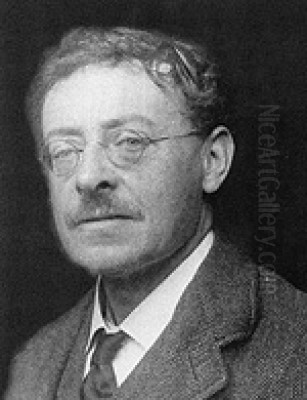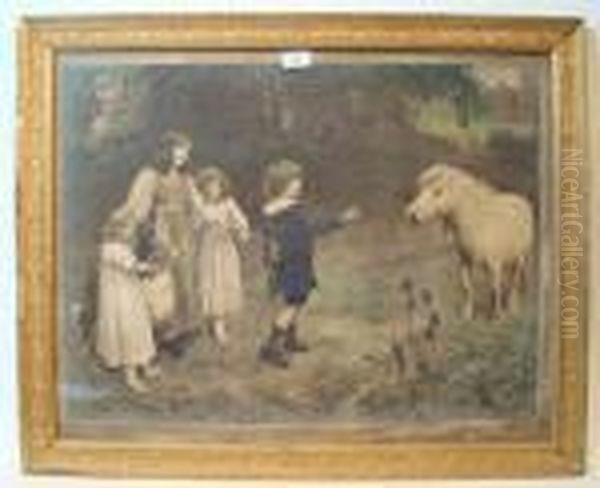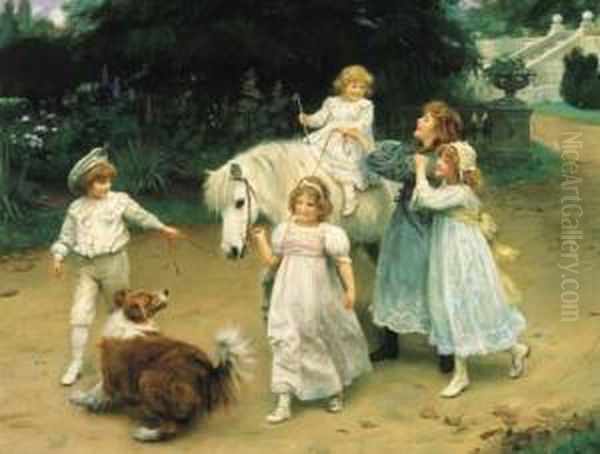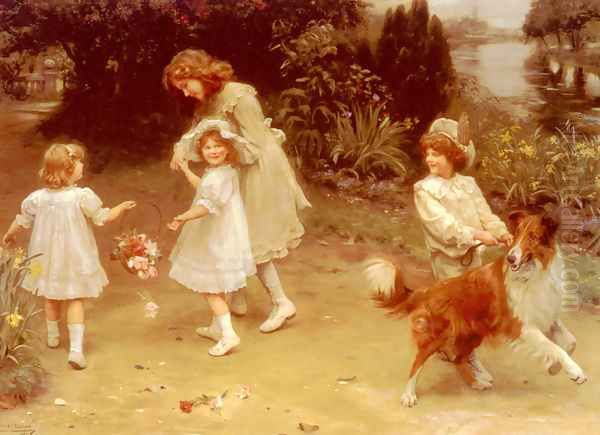
Arthur John Elsley stands as a significant figure in late Victorian and Edwardian British art. Though perhaps not an innovator in the mould of the era's avant-garde, his contribution lies in his masterful, sentimental, and immensely popular depictions of children and their animal companions. His work captured the zeitgeist of an age that idealized childhood and domestic harmony, creating images that resonated deeply with the public and achieved widespread fame through reproductions. Understanding Elsley means understanding a particular facet of British cultural life at the turn of the 20th century.
Early Life and Artistic Foundations
Arthur John Elsley was born in London on November 20, 1860. He was one of six children born to John Elsley, who worked as a coachman but was also an enthusiastic amateur artist, and Emily Ffreer. His father's interest in art undoubtedly played a role in nurturing young Arthur's talent. The elder Elsley often took his son on visits to the London Zoo, experiences which likely sparked Arthur's lifelong fascination with animals and provided early opportunities for sketching.
By the age of eleven, Elsley was already showing considerable promise, particularly in drawing animals. This natural inclination was formalized when, at the young age of fourteen, he enrolled at the prestigious South Kensington School of Art, which would later become the Royal College of Art. This institution was a central hub for artistic training in Britain, providing students with rigorous instruction in drawing and painting.
Elsley's formal training bore fruit quickly. In 1878, while still a teenager, he achieved a significant milestone by having his first painting accepted for exhibition at the Royal Academy of Arts in London. The work, aptly titled 'A Portrait of an Old Horse', signalled the beginning of a long and successful relationship with the Academy, the epicentre of the British art establishment. Exhibiting at the Royal Academy was a crucial step for any aspiring artist seeking recognition and patronage.
The Development of a Signature Style

Following his debut, Elsley continued to develop his skills, initially focusing on animal portraits and scenes, often inspired by his observations at the London Zoo and the countryside. However, his career truly took flight when he began specializing in the subject matter for which he is best known: idyllic and sentimental scenes featuring children, often accompanied by their beloved pets.
This thematic focus tapped directly into the prevailing cultural sentiments of the late Victorian and Edwardian periods. There was a growing idealization of childhood, viewed as a time of innocence, purity, and uncomplicated joy – a stark contrast to the complexities and rapid changes of industrial society. Furthermore, the role of domestic pets, particularly dogs, was evolving, with animals increasingly seen as integral members of the middle-class family, cherished for their loyalty and companionship. Elsley's genius lay in combining these two popular themes into charming, narrative compositions.
His paintings typically depict rosy-cheeked, well-dressed children interacting affectionately with dogs, ponies, cats, or rabbits in pleasant domestic interiors or manicured garden settings. The narratives are usually simple and heartwarming: a shared secret, a playful game, a moment of quiet companionship, or a gentle lesson. His style was characterized by careful draughtsmanship, a bright and appealing colour palette, a smooth finish, and meticulous attention to detail, particularly in rendering the textures of fur, hair, and fabrics. This polished realism made his scenes immediately accessible and relatable to his audience. His work stood in contrast to the grittier social realism tackled by contemporaries like Sir Luke Fildes or Hubert von Herkomer, offering instead an escape into a world of domestic bliss.
Exhibition History and Recognition
Throughout his long career, Arthur John Elsley was a prolific exhibitor. Following his 1878 debut, he became a regular contributor to the Royal Academy's prestigious Summer Exhibition, ultimately showing over fifty paintings there between 1878 and 1927. Consistent acceptance at the RA was a mark of considerable professional success and ensured his work was seen by influential critics, collectors, and the art-loving public.
Beyond the Royal Academy, Elsley's paintings were frequently displayed at other prominent venues across Britain. He exhibited with the Royal Society of British Artists, the Royal Institute of Oil Painters, and at major regional galleries, including the Walker Art Gallery in Liverpool, the Manchester City Art Gallery, the French Gallery, and institutions in Bristol, Birmingham, and Nottingham. He also showed work at the Crystal Palace in London and the Victoria Gallery.

This extensive exhibition record demonstrates the high regard in which his work was held within the mainstream art world of his time. While he may not have courted the controversies or radicalism of artists associated with movements like Impressionism or Post-Impressionism, whose influence was beginning to be felt in Britain, Elsley achieved significant recognition and respect within the academic tradition. His success was comparable to other popular genre painters of the era, such as his contemporary and collaborator Frederick Morgan, or the slightly earlier Charles Burton Barber, who also specialized in child and animal subjects.
Commercial Triumph: The Power of Print
A crucial factor in Arthur John Elsley's immense popularity was the widespread reproduction of his paintings. In an era before widespread colour photography, high-quality colour prints offered the public a way to bring art into their homes at an affordable price. Elsley's charming and accessible subject matter proved perfectly suited for this market.
Leading printing companies, such as C.W. Faulkner & Co. and Thomas Forman & Sons of Nottingham, eagerly sought the copyrights to his most appealing works. These companies employed techniques like chromolithography to create vibrant, detailed reproductions that captured the appeal of the originals. Elsley's paintings became ubiquitous, appearing as calendar illustrations, greeting cards, advertising materials (notably for soap brands like Pears' Soap, which also famously used works by Sir John Everett Millais), book illustrations, and standalone prints for framing.
This commercial success meant that Elsley's images reached a far broader audience than could ever see his original oils in galleries. His work became deeply embedded in the popular visual culture of the Edwardian era, decorating nurseries, parlours, and schoolrooms across Britain and the Empire. This level of popular dissemination, shared by artists like Frederick Morgan, cemented his status as a household name, even if academic art history later tended to favour more formally innovative artists like James McNeill Whistler or members of the Newlyn School such as Stanhope Forbes or Frank Bramley. Elsley's commercial acumen ensured his financial stability and lasting public recognition.
Working Methods and Models
Elsley was known for his meticulous approach to painting. Most of his finished works were composed and executed in his studio, rather than painted entirely from life outdoors in the plein air manner favoured by some contemporaries. He would often pose his child and animal models separately within the studio environment. Props, furniture, and architectural elements would be carefully arranged to create the desired setting.

For outdoor scenes, he relied on landscape sketches and studies made separately, which he would then incorporate into the final composition. This method allowed him greater control over the arrangement and lighting but sometimes led to minor inconsistencies in perspective or scale, particularly as his eyesight began to fail later in life. It was noted that due to deteriorating vision, he sometimes used field glasses or binoculars to observe his models from a distance within the studio, a practice that could potentially flatten perspective.
Finding reliable and appealing models was essential. Elsley frequently drew upon his own family. His daughter, Marjorie, born in 1903, became one of his most regular and recognizable models during her childhood. His wife, Emily (née Ffreer), whom he married in 1893, and her sisters also posed for him over the years. Working with children and animals requires patience, and Elsley developed techniques to capture fleeting expressions and poses, often working quickly to sketch initial impressions before elaborating the details in the final painting. The animals, often terriers, collies, or larger breeds like St. Bernards, were likely pets belonging to his family or friends, chosen for their appealing looks and temperaments.
Collaborations and Conflicts: Frederick Morgan
Elsley's career intersected significantly with that of fellow artist Frederick Morgan (1847-1927), another highly successful painter specializing in sentimental scenes of childhood and rural life. For a period, the two artists enjoyed a close working relationship. This connection was facilitated partly through George Grenville Manton (1855-1932), an artist and illustrator with whom Elsley shared a studio from around 1886. It was Manton who introduced Elsley to Morgan.
When Manton left the shared space in 1889, Elsley moved into Morgan's studio in Hampstead. Their skills were complementary; Morgan excelled at painting figures and rustic settings, while Elsley was particularly adept at depicting animals. For several years, they collaborated on paintings, with Elsley often adding the animals to Morgan's compositions. This arrangement benefited both artists, combining their strengths to create highly marketable works.
However, this productive partnership eventually soured dramatically. Around the turn of the century, a bitter dispute erupted between them. Morgan accused Elsley of stealing one of his ideas for a painting and subsequently exhibiting it as his own. This accusation led to a complete breakdown of their relationship, ending their collaboration and friendship permanently. Such disputes over authorship and originality were not uncommon in the competitive art market, but the rift between Elsley and Morgan was particularly definitive, marking a distinct separation between two artists who had previously worked in close proximity, sharing themes and even models.
A Wider Artistic Context: Elsley and His Contemporaries
Arthur John Elsley worked during a vibrant and diverse period in British art. While he carved out a distinct niche, his work can be understood in relation to various contemporaries and trends. His focus on animals places him in a lineage that includes the great Victorian animal painter Sir Edwin Landseer (1802-1873), whose dramatic and anthropomorphic depictions of animals had set a high bar. Other contemporaries specializing in animal painting included Briton Rivière (1840-1920), known for his sensitive portrayals, and Walter Hunt (1861-1941), who often depicted farmyard scenes.
In the realm of genre painting – scenes of everyday life – Elsley's sentimental narratives found parallels in the work of Frederick Morgan and Charles Burton Barber (1845-1894). However, Victorian genre painting encompassed a wide spectrum. William Powell Frith (1819-1909) created vast, detailed panoramas of modern life like 'Derby Day', while James Tissot (1836-1902), though French-born, spent a significant part of his career in London painting elegant scenes of Victorian high society.
Elsley's polished, academic style contrasted with the looser brushwork and emphasis on light found in British Impressionism or the rustic realism of the Newlyn School painters like Stanhope Forbes (1857-1947) and Frank Bramley (1857-1915), who focused on the lives of fishing communities in Cornwall. While the Pre-Raphaelite Brotherhood (including founder members like Sir John Everett Millais, Dante Gabriel Rossetti, and William Holman Hunt) had represented an earlier challenge to academic norms with their detailed symbolism and medievalism, by Elsley's peak period, figures like Millais had largely transitioned to more conventional, though highly successful, portraiture and genre scenes.
Elsley also worked alongside renowned portraitists like John Singer Sargent (1856-1925) and academic classicists like Sir Lawrence Alma-Tadema (1836-1912), whose opulent depictions of ancient Rome and Egypt were immensely popular. While Elsley's subject matter was humbler, his technical skill and popular appeal placed him firmly within the mainstream of successful late Victorian and Edwardian artists, even if he didn't engage with the more radical artistic currents of his time.
Signature Works: Moments in Time
Over his productive career, Arthur John Elsley created numerous paintings that became iconic representations of Edwardian childhood. While many share similar themes and compositions, several stand out as particularly representative or popular:
'I See You!' (1889): A classic Elsley composition featuring a young girl hiding playfully behind a large St. Bernard dog, embodying the theme of innocent games and the gentle nature of large breeds. The dog acts almost as a furry guardian and accomplice.
'A Tempting Bait' (1906): This work captures a moment of gentle humour and childhood mischief. A small boy, perched precariously on a fence, attempts to lure a large horse closer by offering it an apple. The scale difference between the determined child and the patient horse adds to the charm.
'Special Pleader': A recurring theme for Elsley, often depicting a child interceding on behalf of a pet, perhaps after some minor transgression. These scenes highlight the deep emotional bond between children and animals and the child's role as protector.
'Wake Up!' (1908): Often featuring a child trying to rouse a sleepy dog, these paintings capture the energy of childhood contrasting with the relaxed nature of a beloved pet.
'Golden Hours': This title, used for more than one work, evokes the idealized, sunlit quality of childhood memories that Elsley sought to portray. These scenes often feature children reading or playing quietly in idyllic garden settings.
'Love at First Sight' (1894): Depicting the instant connection between a child and a puppy, this work perfectly encapsulates the sentimental appeal of Elsley's core subject matter.
'Don't Be Greedy': Another narrative scene, likely showing a child teaching a pet manners during feeding time, combining gentle moral instruction with affectionate interaction.
These titles and themes illustrate Elsley's focus on simple, relatable narratives, infused with warmth, humour, and sentiment. His technical skill ensured these scenes were rendered with convincing realism, while his compositional choices emphasized harmony and affection. The consistent quality and appeal of these works solidified his reputation and ensured their enduring popularity through reproductions.
Later Years: Fading Vision, Enduring Fame
The outbreak of World War I marked a turning point, not just for society but also indirectly for Elsley's career. Although he continued to paint and exhibit during the war years, his output began to decline afterwards. A major contributing factor was his deteriorating eyesight. Sources suggest this may have been linked to tuberculosis, which he reportedly contracted.
By the 1920s, the decline in his vision made the meticulous detail work required by his style increasingly difficult. Consequently, his production of new paintings slowed considerably, and his submissions to the Royal Academy ceased after 1927. Despite this challenge, he had already created a substantial body of work that had secured his fame and financial stability through the sale of originals and reproduction rights.
He lived a long life, witnessing significant changes in the art world as modernism gained ascendancy. However, his own style remained rooted in the Victorian and Edwardian traditions he had mastered. Arthur John Elsley passed away in Tunbridge Wells, Kent, on February 19, 1952, at the venerable age of 91. He left behind a legacy of images that continued to evoke nostalgia for a seemingly simpler, more innocent time.
Legacy: Sentiment and Skill
Arthur John Elsley occupies a specific and significant place in British art history. He was arguably the foremost painter of children and pets during the Edwardian era, creating a body of work that perfectly captured the sentimental ideals of his time. His paintings offered comforting, idealized visions of domestic harmony, childhood innocence, and the affectionate bonds between humans and animals.
His technical skill within his chosen genre was considerable. His draughtsmanship was sound, his rendering of textures adept, and his ability to capture appealing expressions in both children and animals was key to his success. While critics might point to a certain predictability or an excess of sentimentality in his work, these were precisely the qualities that endeared him to a vast public audience.
The widespread reproduction of his paintings ensured his images became part of the collective visual memory of the era, shaping popular conceptions of ideal childhood. Even today, his work remains highly collectible, appreciated for its charm, technical competence, and nostalgic appeal. His paintings can be found in several public collections, including the Russell-Cotes Art Gallery & Museum in Bournemouth, the Royal Liverpool Children's Hospital, and various regional galleries, attesting to his historical significance. While not an artistic revolutionary, Elsley was a master craftsman who understood his audience and created enduring images that continue to resonate with viewers seeking warmth and reassurance.
Conclusion
Arthur John Elsley's long career spanned a period of immense social and artistic change. He remained steadfastly dedicated to a vision of idealized childhood and the comforting presence of animal companions. Through technical skill, a keen understanding of popular taste, and the power of mechanical reproduction, he became one of the best-known and most beloved British artists of the late Victorian and Edwardian eras. His paintings serve as charming documents of the aspirations and sentiments of his time, preserving moments of perceived innocence and harmony that continue to hold a powerful nostalgic appeal for subsequent generations. He remains a key figure for understanding the popular visual culture of Britain at the turn of the 20th century.